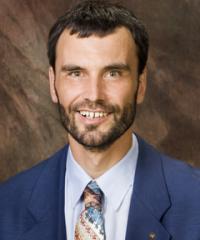- Speaker
- Prof. Roland Winkler
- Department of Physics, Northern Illinois University, USA
- Abstract
Topological insulators are electronic materials that have a bulk band gap like an ordinary insulator but have protected conducting states on their edge or surface. These states are possible due to the combination of spin-orbit interactions andtime-reversal symmetry [1]. Topological insulators can be distinguished from trivial insulators without topological edge states by the values of one or multiple topological invariants that require an analysis of the bulk band structure across the Brillouin zone. Graphene with its simple tight-binding description has served as an archetype for topological insulators [2,3]. We propose an effective two-band Hamiltonian for the electronic states in graphene based on a Taylor expansion of the tight-binding Hamiltonian about the time-reversal invariant M point at the edge of the Brillouin zone[4]. This Hamiltonian provides an accurate description of the topologically protected edge states for both zigzag and armchair edges in graphene ribbons although the concept of a Brillouin is not part of such an effective model. The model highlights the importance of boundary conditions for the occurrence of edge states. Such states occur for band inversion or a mass domain wall at the edge of the ribbon, but they are absent otherwise.
References
[1] M. Z. Hasan and C. L. Kane, Rev. Mod. Phys. 82, 3045 (2010)
[2] C. L. Kane and E. J. Mele, Phys. Rev. Lett. 95, 146802 (2005)
[3] C. L. Kane and E. J. Mele, Phys. Rev. Lett. 95, 226801 (2005)
[4] H. Deshpande and R. Winkler, arxiv:1603.04329
- About the Speaker
Roland Winkler received his PhD from Regensburg University, Germany, in 1994. He was a postdoctoral researcher at Vanderbilt University, USA, Erlangen University, Germany, and Hannover University, Germany. Since 2005 he is Professor of Physics at Northern Illinois University, USA. He is a condensed-matter theorist interested in hard condensed matter, systems in reduced dimensions, electronic phenomena, spins and spin-orbit coupling. He is the author of the book "Spin-Orbit Coupling in 2D Electron and Hole Systems" (Springer, 2003).
- Date&Time
- 2016-08-17 3:15 PM
- Location
- Room: A303 Meeting Room




